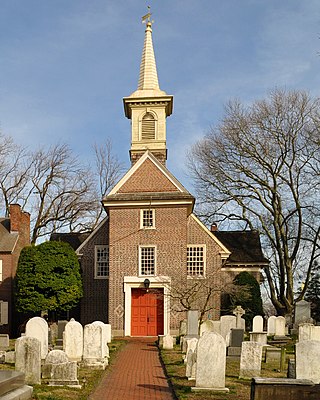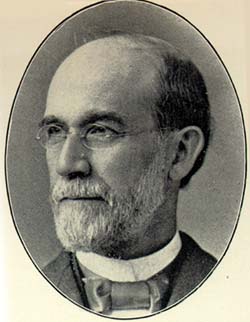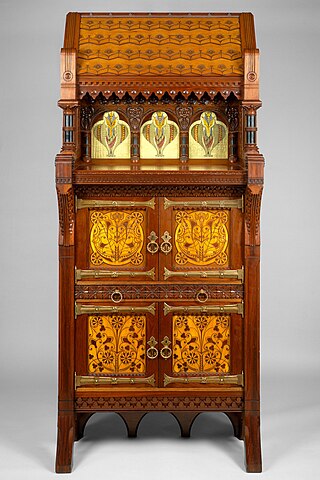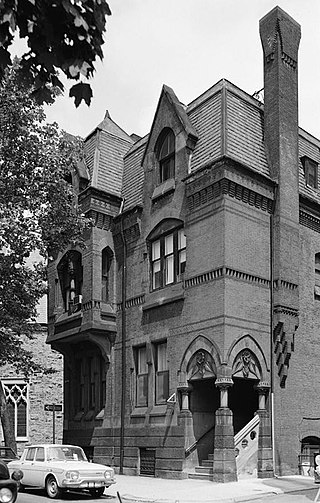
The Centennial International Exhibition of 1876, the first official world's fair to be held in the United States, was held in Philadelphia, Pennsylvania, from May 10 to November 10, 1876, to celebrate the 100th anniversary of the signing of the Declaration of Independence in Philadelphia. Officially named the International Exhibition of Arts, Manufactures, and Products of the Soil and Mine, it was held in Fairmount Park along the Schuylkill River on fairgrounds designed by Herman J. Schwarzmann. Nearly 10 million visitors attended the exposition, and 37 countries participated in it.

Frank Heyling Furness was an American architect of the Victorian era. He designed more than 600 buildings, most in the Philadelphia area, and is remembered for his diverse, muscular, often inordinately scaled buildings, and for his influence on the Chicago-based architect Louis Sullivan. Furness also received a Medal of Honor for bravery during the Civil War.

The Philadelphia History Museum was a public history museum located in Center City, Philadelphia from 1938 until 2018. The museum occupied architect John Haviland's landmark Greek Revival structure built in 1824–1826 for the Franklin Institute. The Museum operated as a city agency as part of Philadelphia's Department of Recreation. The building was listed on the National Register of Historic Places on August 1, 1979.

The Pennsylvania Academy of the Fine Arts (PAFA) is a museum and private art school in Philadelphia, Pennsylvania. It was founded in 1805 and is the first and oldest art museum and art school in the United States.

The architecture of Philadelphia is a mix of historic and modern styles that reflect the city's history. The first European settlements appeared within the present day borders of Philadelphia, Pennsylvania in the 17th century with most structures being built from logs. By the 18th century, brick structures had become common. Georgian and later Federal style buildings dominated much of the cityscape. In the first half of the 19th century, Greek revival appeared and flourished with architects such as William Strickland, John Haviland, and Thomas U. Walter. In the second half of the 19th century, Victorian architecture became popular with the city's most notable Victorian architect being Frank Furness.

G. W. & W. D. Hewitt was a prominent architectural firm in the eastern United States at the turn of the twentieth century. It was founded in Philadelphia in 1878, by brothers George Wattson Hewitt (1841–1916) and William Dempster Hewitt (1847–1924), both members of the American Institute of Architects. The firm specialized in churches, hotels and palatial residences, especially crenelated mansions, such as Maybrook (1881), Druim Moir (1885–86) and Boldt Castle (1900–04).

Memorial Hall is a Beaux-Arts style building which is located in the Centennial District of West Fairmount Park, Philadelphia, Pennsylvania. Built as the art gallery for the 1876 Centennial Exposition, it is the only major structure from that exhibition to survive. It subsequently housed the Pennsylvania Museum of Industrial Art.

The Fisher Fine Arts Library was the primary library of the University of Pennsylvania from 1891 to 1962. The red sandstone, brick-and-terra-cotta Venetian Gothic giant—part fortress and part cathedral—was designed by the acclaimed Philadelphia architect Frank Furness (1839–1912).

Addison Hutton (1834–1916) was a Philadelphia architect who designed prominent residences in Philadelphia and its suburbs, plus courthouses, hospitals, and libraries, including the Ridgway Library, now Philadelphia High School for the Creative and Performing Arts, and the Historical Society of Pennsylvania. He made major additions to the campuses of Westtown School, George School, Swarthmore College, Bryn Mawr College, Haverford College, and Lehigh University.

Wilson Brothers & Company was a prominent Victorian-era architecture and engineering firm established in Philadelphia, Pennsylvania. The company was regarded for its structural expertise.

The Provident Life & Trust Company is a demolished Victorian-era building in Philadelphia designed by architect Frank Furness and considered to be one of the famed architect's greatest works. A bank and insurance company founded in 1865 by members of the Society of Friends (Quakers), the Provident's L-shaped building had entrances at 407–09 Chestnut Street, which served as the entrance to the bank, and at 42 South 4th Street, which was the entrance to the insurance company. The two wings were eventually consolidated into an office building, also designed by Furness, at the northwest corner of 4th and Chestnut Streets.

The Architecture of Buffalo, New York, particularly the buildings constructed between the American Civil War and the Great Depression, is said to have created a new, distinctly American form of architecture and to have influenced design throughout the world.

Willis Gaylord Hale was a late-19th century architect who worked primarily in Philadelphia, Pennsylvania. His flamboyant, highly-ornate style was popular in the 1880s and 1890s, but quickly fell out of fashion at the dawn of the 20th century.
Clarence Howard Clark Sr. was an influential banker, land owner, and developer in Philadelphia, Pennsylvania. Ten years after his death, The New York Times called him one of the city's "most prominent men of his day."

Horace Jayne House (1895) is an architecturally significant building designed by architect Frank Furness in Philadelphia, Pennsylvania, United States. It is located at the southwest corner of 19th and Delancey Streets, about a block south of Rittenhouse Square.

Girard Avenue is a major commercial and residential street in Philadelphia, Pennsylvania. For most of its length it runs east–west, but at Frankford Avenue it makes a 135-degree turn north. Parts of the road are signed as U.S. Route 13 and U.S. Route 30.

Modern Gothic exhibition cabinet is a piece of Modern Gothic furniture now in the collection of the Metropolitan Museum of Art. Although its design was once attributed to Philadelphia architect Frank Furness and furniture maker Daniel Pabst, MMA now credits its design and manufacture to Pabst alone. At 8 feet (2.4 m) tall, it is an unusually large and polychromatic American example of the rare style.

The Thomas Hockley House (1875) is a Victorian city house in Philadelphia, Pennsylvania, designed by architect Frank Furness. Located west of Rittenhouse Square, it is a contributing property in the Walnut–Chancellor Historic District.

Walter Rogers Furness Cottage (1890-1891) – also known as the "Old Infirmary" or the "Jekyll Island Infirmary" – is a Shingle Style building on Jekyll Island, in Glynn County, Georgia.
Daniela Holt Voith is an American architect. She is the Founding Partner and Director of Design at Philadelphia-based architecture studio Voith & Mactavish Architects, LLP and is Fellow of the American Institute of Architects (FAIA). She has worked extensively providing planning and design services with schools and universities including the University of Pennsylvania Carey Law School, Yale University, and boarding schools such as Millbrook School, The Lawrenceville School, and St. Andrew’s School, where the film Dead Poets Society was shot. The firm's major projects also include preserving, rehabilitating, and additions to National Historic Landmarks such as the Mercer Museum, Bryn Mawr Film Institute, Old Library at Bryn Mawr College, and the former Centennial National Bank, now the alumni center for Drexel University. She is married to economist Richard Patrick Voith, Chairman of Econsultsolutions Inc., who is a fellow at the University of Pennsylvania's Institute of Urban Research and adjunct faculty at Wharton. As of 2019, she is the President of the Philadelphia Chapter of the Institute for Classical Architecture and Art. She sits on the board of the Design Leadership Foundation and is a director of the Carpenter’s Company of Philadelphia.


























